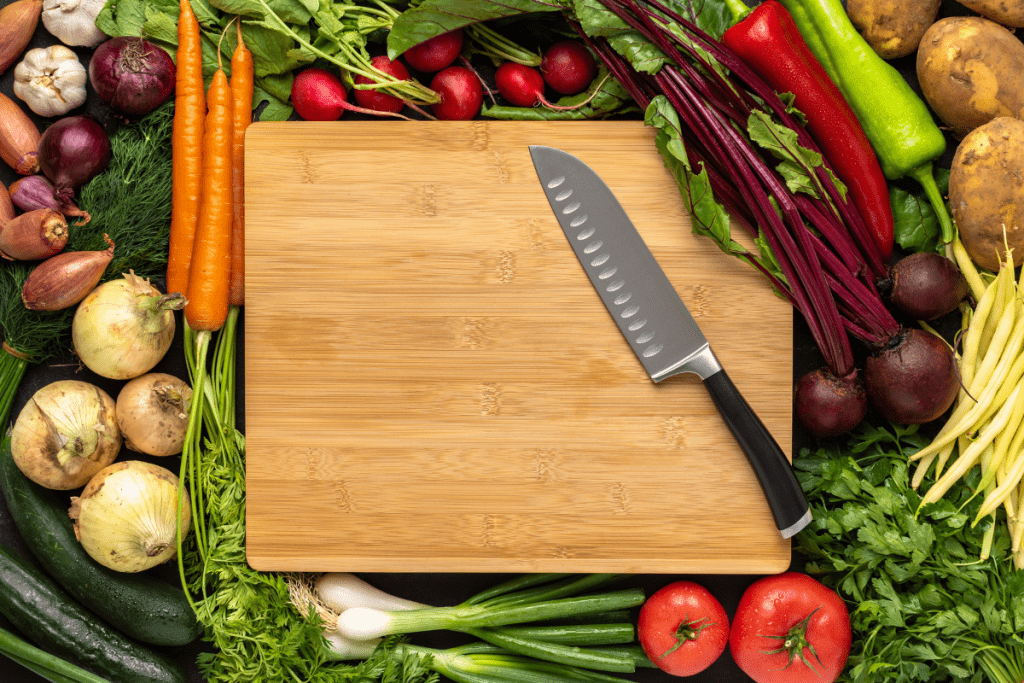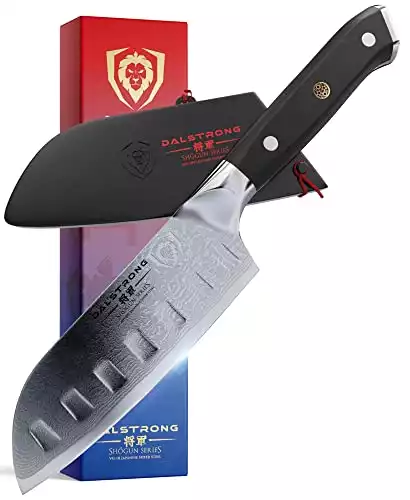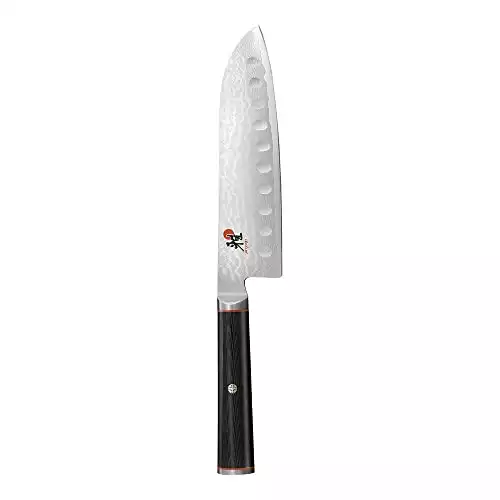Are you looking to upgrade your kitchen knives? Is ease of use an important consideration?
If so, a Santoku knife might just be a great fit. It’s the perfect meld of Japanese blade making and Western design.
As a professional cook who has spent a decade doing food prep, including years under a sushi chef in Portland, I understand there are few things more important than having the right knife for the job.
In this article, I’ll teach you how to choose the best santoku for your cooking style and share the pros and cons of my favorite options. This is based on a decade of first hand experience which should help you make an informed decision and avoid common mistakes that many buyers make.
I’ll also walk you through the basics principles that cause a Santoku to perform differently than other top Japanese knives like the Gyuto, and the merits of common design features like Damascus steel.
In This Article
Our Top Picks
- Razor sharp blade
- Excellent balance
- Low maintenance
- Very affordable for a santoku
- Sharp and durable blade edge
- Perfectly balanced for effortless cuts
- Damascus steel blade blends sharpness and durability
Best Overall: Shun Classic 7 Inch Santoku Knife
What makes a blade the best santoku knife? In the case of Shun’s Classic series santoku, it’s a finely tuned combination of balance, sharpness, and edge retention. Combined with lower maintenance than other Japanese knives, those qualities put the Shun santoku in a league of its own.
The blade for classic series santoku by Shun is made of a high carbon stainless steel. This combines the best aspects of both Eastern and Western knives. The result? A knife that’s incredibly sharp, holds an edge well, and won’t corrode if it gets damp. What more can you ask for in an all-purpose kitchen knife?
In addition to its exemplary blade construction, Shun’s santoku is perfectly balanced. The full tang construction gives an equal weight to the handle and the blade, mediated by a thick connection at the handle. This leaves the knife feeling almost weightless, cutting through fruits, vegetables, and meat with ease.
Where other Japanese blades need a lot of maintenance, Shun’s santoku is easy to care for. Though it has a Damascus steel look, it’s actually clad in 16 layers of stainless steel. Simply dry it off and store it safely, and this knife will be in great shape for years to come.
Overall, Shun’s santoku is a top notch example of Japanese craftsmanship blended with Western innovations. It’s the sharpest multi-purpose knife that you’ll find, with low maintenance requirements. If you’re looking for one knife that can take care of a majority of your chopping, slicing, and dicing, this knife deserves a place in your kitchen.
What we like
- Razor sharp blade
- Excellent balance
- Low maintenance
What We don’t
- As expensive as a high quality chef’s knife
Most Affordable: Dalstrong Shogun Series 7 Inch Santoku Knife
The combination of high carbon stainless steel and processing methods used for Dalstrong’s santoku yield a greater hardness than any other knife in this guide. Measuring a full 62 on the Rockwell scale, this blade has the potential to take an amazingly sharp cutting edge. That also means that it’s more prone to chipping though, and makes it harder to sharpen at home.
A full tang construction means that this knife is quite well balanced. The hollow ground blade reinforces this, making for a knife that prevents food from sticking while you’re cutting. And with a 7 inch blade, you’ll be well equipped to slice through everything from tomatoes to root vegetables and poultry.
Dalstrong’s santoku knife is a serious contender for best santoku knife, even at its lower price point. It’s made using the same high carbon stainless steel of other top santoku knives, and its razor sharp edge will make quick work of anything you need to cut. If it wasn’t for the shape of the handle, this knife may well have been my top pick.
Though it’s well balanced, the Western-style handle makes this knife feel awkward to use for making the straight cuts that santoku knives are used for. If you’re already familiar with this type of handle, this can be a benefit. But if you’re looking to familiarize yourself with Japanese knives, it’s not a good representation of their style.
Because of that, I would recommend Dalstrong’s Shogun series knife not just to anyone who’s on a tighter budget, but specifically to people who are comfortable with this type of handle. It handles more like a Western chef’s knife than a Japanese blade, which is a matter of personal preference.
What we like
- Very affordable for a santoku
- Sharp and durable blade edge
What We don’t
- Western style handle may not be to everyone’s tastes
- Needs to be sharpened by a professional
Best Upgrade: Miyabi Kaizen Hollow Edge Santoku Knife
The difference between the best santoku knife you can get and a decent kitchen knife is a matter of attention to detail. In the case of Miyabi’s Kaizen santoku knife, that attention to detail leads to an impeccable balance that makes for smooth and easy cuts every time. If you have the extra money to invest in it, the Miyabi is easily the best santoku knife you can get for your kitchen.
Damascus steel is the benchmark by which all other Japanese blades are judged. Inherited from traditional Japanese sword making, the Damascus process folds layers of low and high carbon steel to create incredibly sharp and durable blades. All of the best santoku knives in the world use this process to create blades worthy of a modern-day kitchen samurai.
The blade for Miyabi’s Kaizen knife splits the difference between Western and Eastern style knives. Measuring in at 60 degrees Rockwell, it’s able to take a powerfully sharp edge but doesn’t suffer from the fragility of other Japanese blades. Rather than go for the sharpest blade possible, it’s a perfect compromise between sharpness and durability.
Add in a hollow edge that prevents foods from sticking to the blade, and you’ve got a knife that’s an absolute joy to use. Don’t get me wrong — you don’t need to have an expensive Miyabi knife in your kitchen. But if you want every meal in your kitchen to be a unique and enjoyable experience, this knife will get you there.
What we like
- Perfectly balanced for effortless cuts
- Damascus steel blade blends sharpness and durability
What We don’t
- Fairly expensive
Runners Up: Great, But Not the Best
The three knives that I just covered represent the best of the best in their respective categories. Before I decided on them as my recommendations though, I thoroughly compared them to other santoku knives. Here are a few other blades that are great, but didn’t make the cut:
Mac Knife Superior Santoku Knife
Wow, Mac Knife’s santoku is affordable! It’s even made in Japan, which you don’t see often with budget-priced knives. But quite honestly, that’s where the good times end. It’s made with lower quality steel than any of my top picks, and the balance is off. If you absolutely need a santoku knife for under $100, go for it. But I’d recommend saving up just a bit more and getting a knife that will last longer.
Victorinox Fibrox Santoku Knife
Though it’s incredibly affordable, I can’t wholeheartedly recommend Victorinox’s Fibrox santoku knife to you. The handle is simply too light, and doesn’t give any sort of balance to the knife. Even though the blade is quite sharp, this will leave you struggling through your cuts.
Wusthof Santoku Knife
Wusthof’s hollow ground stainless steel blade is a great touch for a santoku knife, but it’s too expensive. For almost the same price, it’s better to go for a Miyabi santoku. They’re a sister company of Wusthof, but they specialize in Japanese blades with better performance.
Buyer’s Guide: How to Choose the Best Santoku Knife
In this section, I’ll share the criteria I used to decide on my santoku knife recommendations. That way, you’ll be prepared to make your own judgment on what the best santoku knife for your home kitchen is.
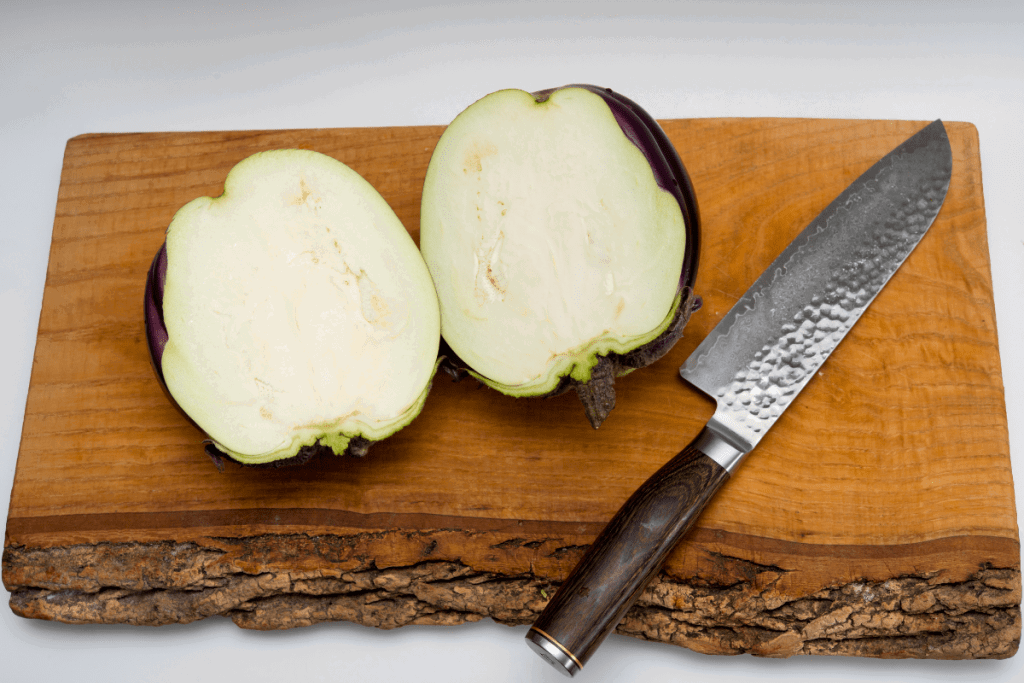
Blade
Santoku knives are renowned for the sharpness of their blades. That’s a direct result of the type of steel used, as well as the techniques employed in forging the blade. Don’t settle for anything less than high carbon steel. Then, look for knives that are made using time-honored Japanese knife making processes.
Handle
The handle of a santoku knife should provide three things:
- A firm and slip-resistant grip. Wood or hard composite handles are great for this, and look good at the same time. Traditional D-shaped handles accommodate a wide range of grip styles.
- Balance with the blade. A good santoku knife will feel almost weightless in your hand, and make cuts with ease.
- Durability. Full tang construction extends the metal of the blade through the handle, making a strong and long-lasting knife.
Size
Blades for santoku knives come in a range from 5 to 8 inches long. While the size for the best santoku knife will vary from person to person, I’m strongly in favor of 7 inch blades. They’re more compact than a chef’s knife, but still give you plenty of blade to work with for making long cuts. Any shorter and the knife will feel more like a paring knife; any longer, and you may as well use a chef’s knife instead.
Recommended Reading: All-around manual to Japanese knives
Affordability
As with all traditional Japanese blades, buying the best santoku knife will not be cheap. That said, there’s a big difference between expensive knives that are worth the investment and those that are overpriced! To get a top quality santoku knife that will last for decades of faithful service, I recommend budgeting between $100 and $200 in total.
Maintenance
Most Japanese knives are notorious for their frequent maintenance requirements. Between sharpening, oiling, and keeping them completely dry, those requirements scare away a lot of beginning cooks.
If that’s the case for you, a santoku knife is a perfect alternative. They’re made with the same sharpness and edge retention of other Japanese knives, but Western processing methods can make them stain-resistant. As a result, the only maintenance you’ll need to worry about is storing them safely and occasionally sharpening them.
My Recommendations
To wrap things up, I’d like to take a moment to thank you for researching kitchen knives before buying one. It’s easy to purchase the first knife that grabs your attention, but you’ve taken the time to really dig into which knife is best for you. And for that, I commend you!
My first recommendation for anyone looking for a santoku knife is the Shun Classic 7 Inch Santoku Knife. If you’re looking to save a few dollars but still get a top quality knife, then the Dalstrong Shogun Series 7 Inch Santoku Knife is a better choice. Alternatively, invest just a bit more and you can have the lifelong performance of the Miyabi Kaizen Hollow Edge Santoku Knife.
But honestly, any of the knives featured here will boost your kitchen confidence. So get out there and find some new recipes to make with your new santoku!
FAQs
The santoku knife is a recent addition to knife making, so it’s natural to have plenty of questions about it. Let’s wrap things up by taking a closer look at the most common questions about santoku knives.
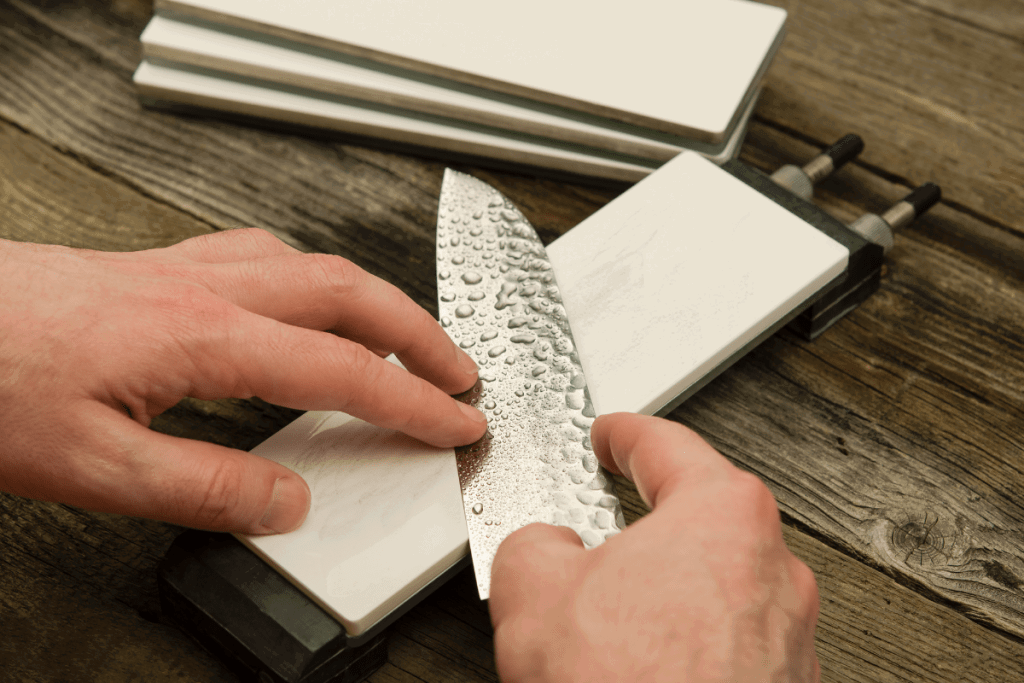
Why Is the Santoku Knife Special?
The secret of the santoku knife lies in its name. Literally translated, santoku means “three virtues” or “three uses”. And while the exact meaning of that term is debated, evidence points toward the knife being named for its ability to chop, slice, and dice. Alternatively, it may refer to the knife’s ability to cut vegetables, meat, and fish with ease.
Besides the best chef’s knives, no other knife in the kitchen is as versatile and easy to use as the santoku! Being able to take care of all of your slicing dicing and mincing tasks with one knife puts the santoku knife in many chef’s good graces. Whether you’re outfitting your kitchen for the first time or replacing a knife, a santoku knife deserves a spot in your home.
Are There Any Drawbacks to the Santoku Knife?
The main drawback of the santoku knife is the same as every other Japanese knife: Their blades are prone to chipping. This is a direct result of the hardness of the Japanese steel used for the blade.
In my mind though, that’s a fair tradeoff for the increased sharpness and edge retention that Japanese steel offers. Avoid cutting on glass, ceramic, or granite cutting boards and don’t run your santoku knife into bones, and you’ll be a-okay.
What Is the Difference Between A Santoku and Chef’s Knife?
The design of the santoku knife is actually a cross between traditional Japanese chef’s knives and modern Western chef’s knives. So while the uses for santoku and chef’s knives are similar, there are two main differences:
1. Santoku knives have a completely straight blade edge. Also known as a “sheep’s foot” style blade, this means that you won’t be using a rocking motion to cut. Instead, you can push a santoku knife straight through your ingredients. Once you get used to this style of cutting, it’s extremely convenient for dicing and mincing onions and garlic.
2. Santoku knives are shorter than chef’s knives. Their blades measure between 5 and 8 inches long, as compared to the 8 to 12 inches of most chef’s knives. That makes santoku knives easier for beginners to handle.
It can be helpful to have a full picture of the parts of a knife to understand the difference.
Do I Need a Santoku Knife If I Have a Chef’s Knife?
As mentioned above, santoku and chef’s knives have very similar functions. So if you already have a chef’s knife, should you consider buying a santoku as well?
In my experience, it’s worth adding a santoku knife to complement your chef’s knife in the following cases:
You’re a beginner or intermediate home cook that’s still working on knife skills. Santoku knives were designed with home cooks in mind, and are easier to use than full-fledged chef’s knives. Practice with a santoku, and you’ll develop the confidence necessary to deftly use a chef’s knife.
You already have a chef’s knife, and you want to cook with your partner. Instead of buying another chef’s knife for your other half, get a santoku. Then you’ll have two multipurpose knives to choose from.
What Sort of Cuts Should I Make With My Santoku?
Versatility is the santoku’s strong suit. If there’s a cut you have in mind, the santoku can do it. That includes chopping, slicing, dicing, mincing, julienning, brunoising, chiffonading — whew! Safe to say, more cuts than almost any other knife.
There’s one sort of cut you should not make with your santoku, though. Whatever you do, don’t use a santoku for cutting through bones. The extra hard blade will be in danger of chipping. Look out for tricky small bones in poultry and fish, too, as even these can be enough to put a crack in your blade.
